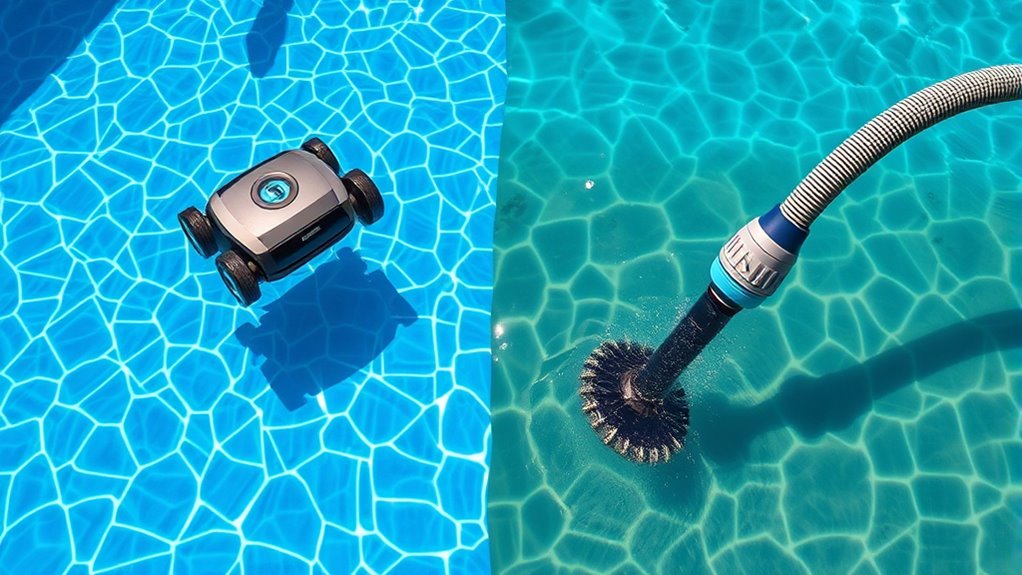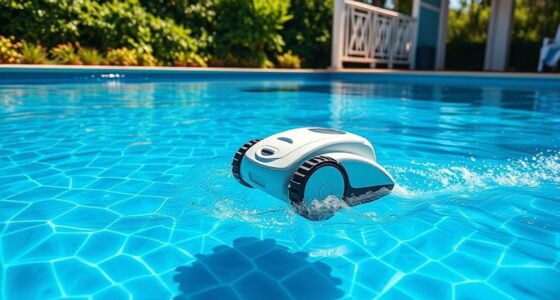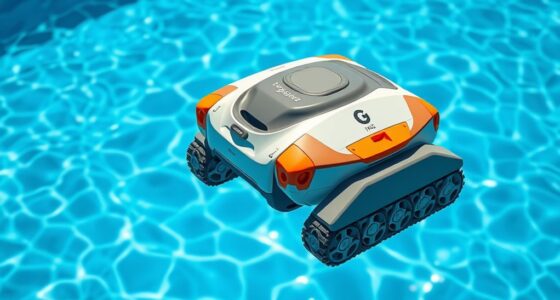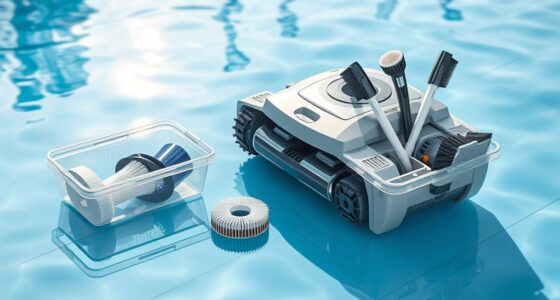Robotic pool cleaners excel in thorough, efficient cleaning, especially for complex shapes and hard-to-reach spots, thanks to their advanced navigation and sensors. They offer better dirt removal, higher customization, and often operate quietly, but come at a higher initial cost and may require more upfront maintenance. Suction cleaners are more budget-friendly and easier to set up but depend heavily on your pool’s filtration system and may miss spots. To discover which fits your pool best, keep exploring the details ahead.
Key Takeaways
- Robotic cleaners offer superior navigation and thorough coverage, especially for complex pool shapes, while suction cleaners follow random paths with less precision.
- Robotic units have advanced features like smart sensors and remote control, but typically come with higher upfront costs compared to more affordable suction cleaners.
- Robotic cleaners are energy-efficient and require minimal manual intervention, whereas suction models depend on pool pump power, increasing operational costs.
- Suction cleaners are simpler to set up and maintain, making them suitable for smaller budgets, while robotic cleaners need regular filter and brush maintenance.
- For large or intricate pools, robotic cleaners provide better cleaning performance, whereas suction cleaners are more practical for straightforward, smaller pools.
Overview of Robotic Pool Cleaners
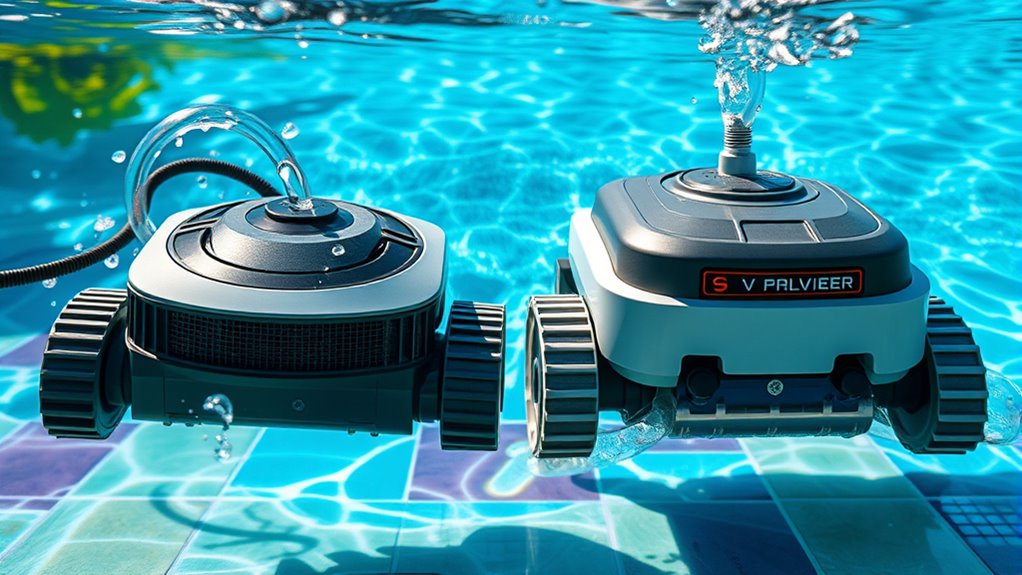
Robotic pool cleaners are automated devices designed to keep your pool spotless with minimal effort. They work well regardless of your pool’s material, whether it’s concrete, vinyl, or fiberglass, adapting to different surfaces for thorough cleaning. Your pool’s shape also influences how a robotic cleaner performs; whether it’s rectangular, kidney-shaped, or freeform, these cleaners navigate efficiently thanks to their advanced programming. They use brushes and filters to scrub away dirt, algae, and debris, collecting it in onboard bins. Unlike traditional cleaners, robotic models operate independently, often with programmable schedules. This flexibility makes maintaining your pool easier, saving you time and effort—especially if you have a complex shape or specific pool surface that needs careful attention. Additionally, ongoing advancements in AI security are helping improve the navigation and efficiency of these devices. Modern robotic cleaners also benefit from high-quality sensors, which enhance their ability to detect and adapt to various pool conditions for more effective cleaning. Incorporating efficient filtration systems further ensures debris is captured effectively, extending the lifespan of your pool equipment. Regularly updating and maintaining these components can also help prevent clogging and ensure optimal performance. Furthermore, integrating advanced navigation technology can significantly improve cleaning coverage and reduce missed spots.
Overview of Suction Pool Cleaners
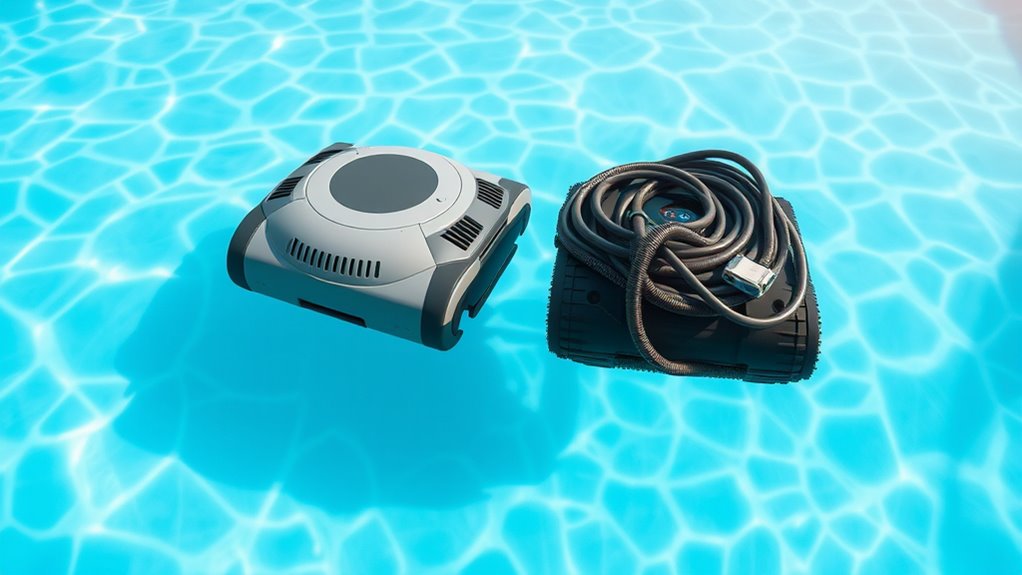
Suction pool cleaners are simple, effective devices that attach to your pool’s filtration system to keep surfaces free of debris. They work by creating suction, which pulls dirt and leaves into their built-in baskets or your pool’s skimmer. These cleaners are straightforward to set up and require minimal supervision, making them ideal for regular pool maintenance. However, it’s essential to follow safety precautions, such as disconnecting power during maintenance and ensuring proper installation to prevent damage. Suction cleaners are cost-effective and reliable for cleaning floors and walls, but they may struggle with larger debris or complex pool shapes. Regular checks and proper use help maintain your pool’s cleanliness and prolong equipment lifespan. Additionally, understanding the sound healing science behind certain vibrations can help optimize the efficiency of your cleaning devices by reducing operational noise and vibrations. Proper maintenance of the equipment components, such as replacing worn-out hoses or filters, is also crucial for sustained performance. Incorporating regular maintenance routines can further improve the longevity and performance of your suction pool cleaner. Using appropriate automation technology can help streamline the cleaning process and reduce manual effort, enhancing overall efficiency.
Cleaning Performance and Effectiveness
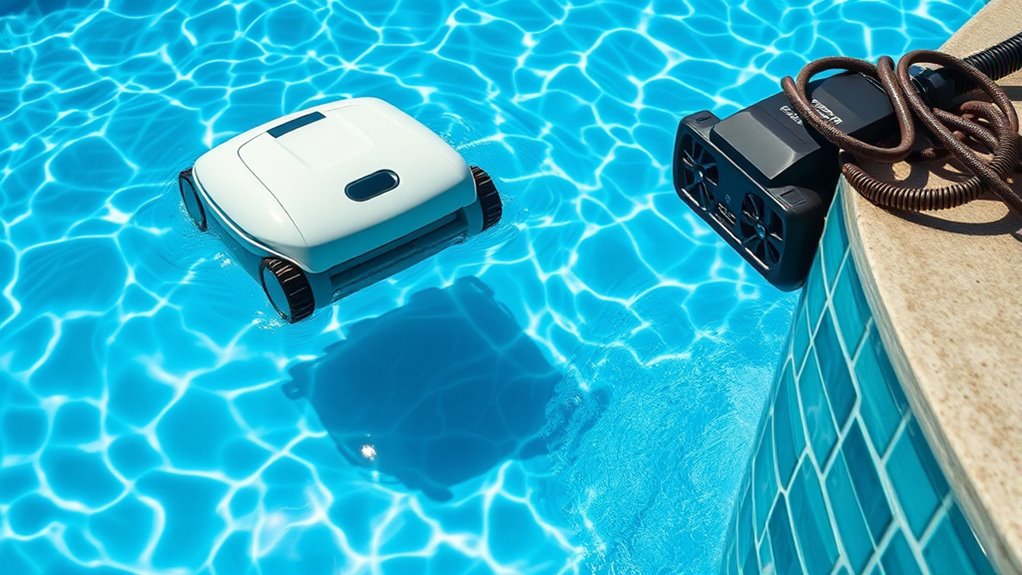
When it comes to cleaning performance, you’ll want a device that covers your pool efficiently and thoroughly. Both robotic and suction cleaners have strengths in removing dirt and debris, but their effectiveness can vary. Let’s compare how well each type handles dirt removal and overall coverage to help you choose the best option. For example, robotic cleaners, like the advanced models used in Honda Tuning for precise control and coverage, can often navigate complex pool shapes more effectively than simple suction models. Additionally, robotic cleaners typically include programmable settings that enable customized cleaning cycles for different pool conditions, enhancing their overall effectiveness. These programmable features are similar to ECU remapping in car tuning, which optimizes performance based on specific needs. Studies also show that digital literacy programs can assist seniors in mastering new cleaning technologies, ensuring optimal use and maintenance of these devices. Moreover, robotic cleaners often incorporate sensor technology that detects dirt and obstacles, increasing cleaning efficiency.
Cleaning Efficiency and Coverage
While both robotic and suction pool cleaners are designed to keep your pool spotless, their cleaning efficiency and coverage can vary considerably. Robotic cleaners often excel in navigation accuracy, allowing them to methodically cover the entire pool surface. They typically have a higher cleaning speed, which means quicker results. Suction cleaners, on the other hand, rely on the pool’s existing filtration system, which can limit their coverage and navigation precision. Consider these points:
- Robotic cleaners map the pool area for thorough coverage.
- Suction cleaners follow random paths, risking missed spots.
- Robotic units adapt to obstacles, improving efficiency.
- Suction cleaners often clean faster in smaller pools but may miss some areas.
- Data collection and analysis by robotic cleaners help optimize their cleaning paths for better performance, and advancements in navigation technology continue to enhance their accuracy. Additionally, the integration of smart features in modern robotic cleaners allows for even more precise and customizable cleaning schedules.
Dirt and Debris Removal
Robotic pool cleaners generally deliver superior dirt and debris removal compared to suction models, thanks to their dedicated scrubbing brushes and advanced filtering systems. These robots often feature multiple filter types, such as fine mesh or cyclonic filters, which trap even tiny particles for a cleaner pool. Their precise navigation helps target stubborn dirt in hard-to-reach areas. Battery life varies but usually lasts long enough to complete thorough cleaning cycles without interruption. This extended runtime guarantees more debris is collected in a single session, reducing the need for manual cleanup. Additionally, their navigation systems allow for systematic coverage of the entire pool surface, ensuring no area is overlooked. Modern robotic cleaners also incorporate smart technology that enables remote control and scheduling for added convenience. The integration of efficient motor technology enhances their cleaning power while maintaining energy efficiency. Overall, robotic cleaners excel at removing dirt and debris efficiently, maintaining a pristine pool with minimal effort. Their combination of effective filters and reliable battery performance makes them a top choice for thorough pool maintenance. Proper maintenance of these systems ensures optimal performance and longevity.
Ease of Use and Operation

Robotic and suction pool cleaners differ markedly in how easy they are to operate. With robotic cleaners, you often enjoy features like remote operation, allowing you to start or stop cleaning from a distance. They usually have intuitive interfaces and minimal manual controls, making setup straightforward. Suction cleaners, on the other hand, tend to rely on manual controls and require you to connect them to your pool’s skimmer or dedicated suction line. To compare:
- Robotic cleaners often feature remote control for convenience.
- They usually need less manual intervention during operation.
- Suction cleaners require manual connection and setup.
- Operating robotic cleaners can often be as simple as pressing a button.
Cost and Budget Considerations
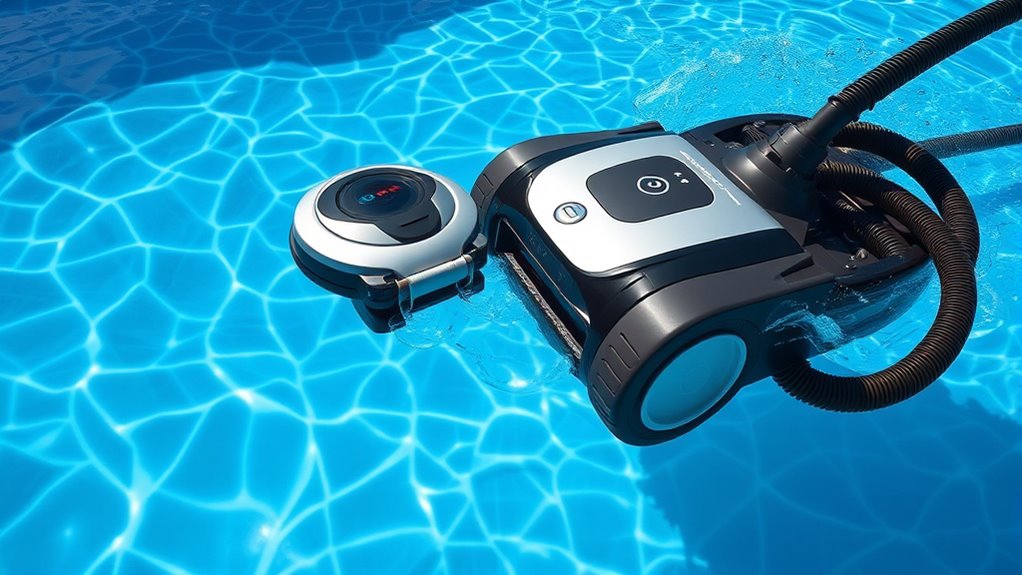
Cost is a significant factor when choosing between robotic and suction pool cleaners. Robotic cleaners typically have higher upfront costs but can save money over time with less maintenance. Suction cleaners are generally more affordable initially but may require more frequent replacements or repairs. If budget constraints are tight, suction cleaners offer better affordability options. Consider these points:
| Aspect | Robotic Cleaner | Suction Cleaner |
|---|---|---|
| Initial Cost | Higher | Lower |
| Maintenance | Moderate | Potentially higher |
| Long-term Savings | Yes | Limited |
| Replacement Costs | Higher | Lower |
| Affordability Options | Limited | Better options |
Choosing based on your budget helps you balance upfront expenses with ongoing costs effectively.
Maintenance and Durability
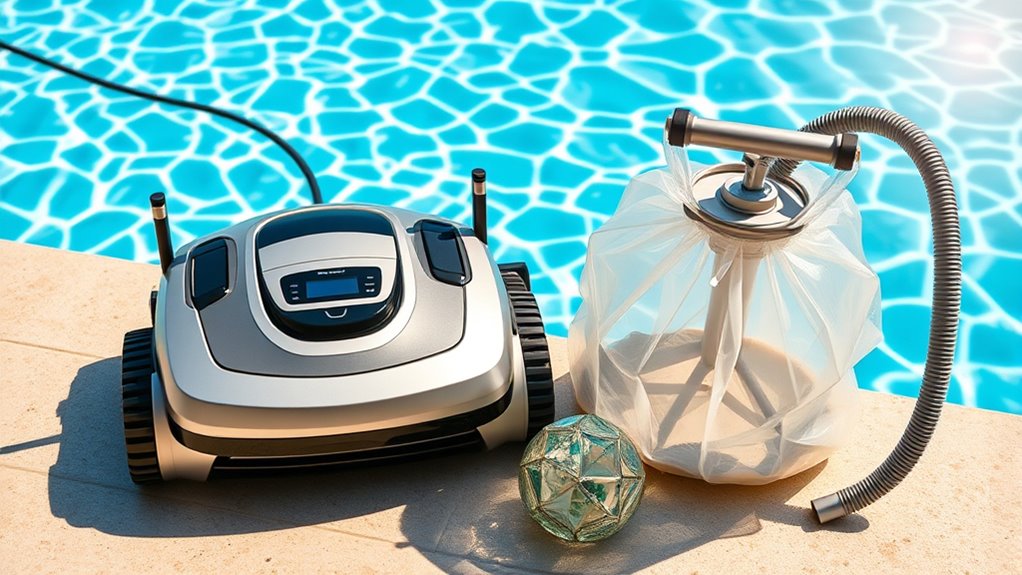
While both types of pool cleaners require regular maintenance, their durability and long-term performance can differ markedly. Robotic cleaners often have better corrosion resistance due to sealed motors and durable materials, extending their lifespan. Suction cleaners, however, may experience more wear and tear, especially with filter replacement needs. To keep your cleaner performing well:
Robotic pool cleaners offer greater durability thanks to sealed motors and resistant materials.
- Check and replace filters regularly to prevent clogs.
- Clean brushes and wheels to avoid buildup.
- Inspect power cords and connections for damage.
- Store units properly to avoid corrosion and damage.
Robotic cleaners typically withstand harsh conditions better, making them more durable over time. Suction models might need more frequent repairs or replacements, impacting long-term performance. Proper maintenance guarantees you get the most out of your investment.
Energy Efficiency and Power Consumption
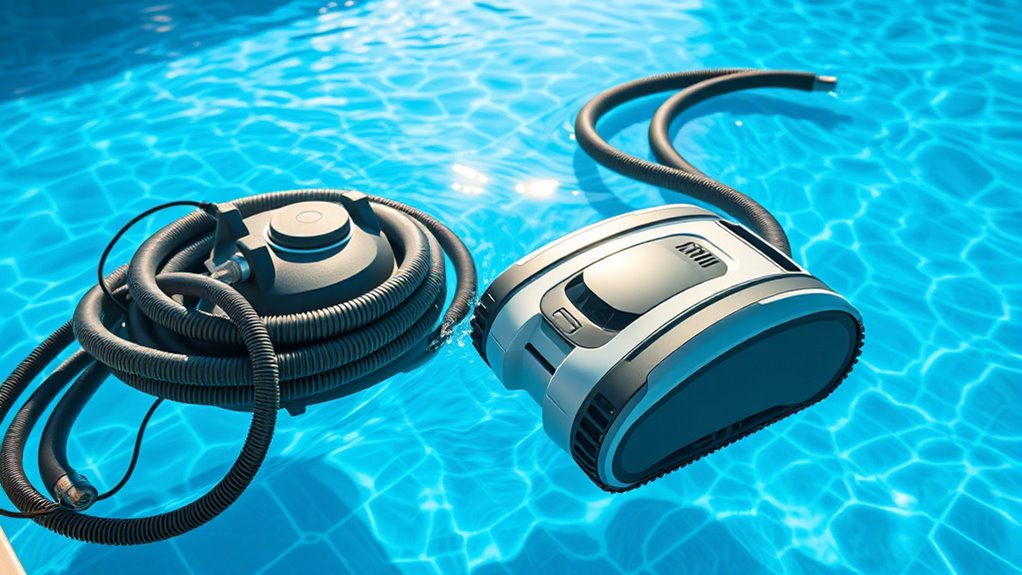
You’ll want to contemplate how much power each cleaner uses, as lower energy consumption can save you money over time. Many models now include energy-saving features that automatically reduce power when cleaning isn’t needed. Comparing these aspects helps you choose a more efficient option for your pool.
Power Usage Levels
Robotic and suction pool cleaners differ markedly in their energy efficiency and power consumption, impacting long-term operating costs. Robotic cleaners typically have better energy consumption, using less power for extended cleaning sessions due to optimized motors and efficient design. Conversely, suction models often draw more power because of their continuous operation and reliance on pool pumps. Here’s what you should consider:
- Robotic cleaners usually consume less energy, saving you money over time.
- Suction cleaners depend on your pool pump, which may increase overall power use.
- Power efficiency in robotic models translates to less strain on your electrical system.
- Longer operation times in suction cleaners can lead to higher energy bills.
Understanding these differences helps you choose a cleaner aligned with your energy-saving goals.
Energy Saving Features
Energy-saving features in pool cleaners directly affect their overall efficiency and cost-effectiveness. By incorporating options like solar power, you can markedly reduce energy consumption while maintaining effective cleaning. Solar-powered pool cleaners utilize renewable energy, promoting energy conservation and lowering your electricity bills. Look for models with intelligent power management systems that optimize operation times and reduce unnecessary energy use. Features like automatic shutoff during idle times and adjustable cleaning modes help you control power consumption without sacrificing performance. Suction and robotic cleaners with these energy-efficient features are better for the environment and your wallet. Choosing a cleaner with energy-saving capabilities ensures you keep your pool clean while minimizing your ecological footprint and operational costs.
Features and Technological Advancements

Advancements in technology have substantially enhanced the features of both robotic and suction pool cleaners, making them more efficient and user-friendly. Today’s models leverage smart navigation, allowing cleaners to map and clean pools systematically. Wi-Fi connectivity enables remote control via smartphone apps, giving you real-time updates and scheduling options.
Consider these key features:
- Smart navigation helps avoid missed spots and reduces cleaning time.
- Wi-Fi connectivity lets you start, stop, or monitor cleaning sessions from anywhere.
- Sensor technology detects obstacles and adjusts the route accordingly.
- Enhanced filtration systems capture fine debris for cleaner, clearer water.
These advancements guarantee your pool stays pristine with minimal effort on your part.
Suitability for Different Pool Types
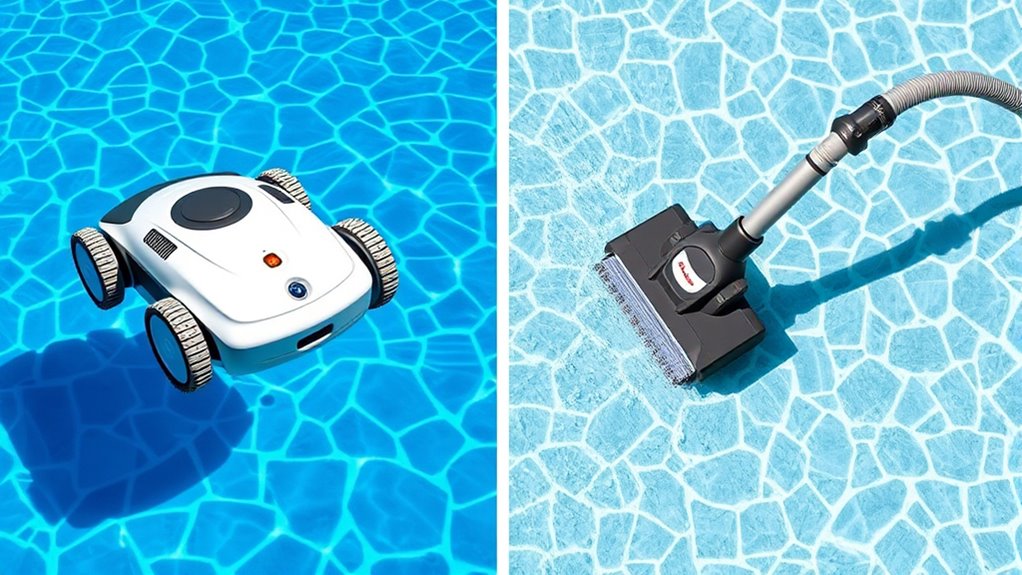
Choosing the right cleaner depends on your pool type. Robotic and suction models vary in compatibility with inground and above-ground pools, so you’ll want to contemplate your setup. Additionally, pool size can influence which cleaner works best for your needs.
Inground Pool Compatibility
When it comes to inground pools, not all robotic or suction pool cleaners are equally compatible. Your pool’s surface compatibility and installation requirements play a big role. Here are four key points to evaluate:
- Surface Type: Some cleaners work best on smooth surfaces like plaster, while others handle textured finishes or pebble tiles better.
- Pool Size: Larger pools may need more powerful suction or longer-running robotic units.
- Accessibility: Verify the cleaner’s installation process fits your setup—suction cleaners often require simpler hookups, while robotic models might need dedicated power sources.
- Obstacles and Features: For pools with steps, drains, or intricate shapes, select a cleaner designed for complex surfaces and effective navigation.
Matching your pool’s specifics guarantees ideal cleaning and compatibility.
Above-Ground Pool Fit
Above-ground pools require specific types of cleaners to guarantee effective and efficient maintenance. Suction pool cleaners work well with above-ground pools because they can easily navigate around pool covers and tight corners. These cleaners can handle debris near the pool cover’s edge and clean around pool lighting fixtures without hassle. Robotic cleaners are also suitable, especially if your pool has complex shapes or hard-to-reach areas, as they can be programmed for targeted cleaning. Both types easily adapt to the pool’s structure, but suction models are often more budget-friendly for above-ground pools. Keep in mind, the cleaner’s size and maneuverability are vital to avoid damaging pool covers or lights, ensuring your above-ground pool stays clean and well-maintained.
Pool Size Considerations
Pool size substantially influences which cleaner works best for your setup. Larger pools require equipment with extensive cleaning coverage, while smaller pools can be maintained with more compact options. Consider these points:
- For small to medium pools, a robotic cleaner offers thorough coverage and flexibility.
- Large pools benefit from suction cleaners with longer hoses or cords, covering more area efficiently.
- Extremely large or irregularly shaped pools might need professional-grade cleaners for complete cleaning coverage.
- Pool size also determines cleaning frequency—bigger pools need more regular maintenance to stay sparkling.
Ultimately, matching your pool size with the right cleaner ensures comprehensive cleaning coverage, saving you time and effort while keeping your pool pristine.
Making the Right Choice for Your Pool

Choosing the right pool cleaner depends on your specific needs and the environment of your backyard. Consider your pool’s color, as darker pools may show dirt more prominently, requiring a cleaner with strong scrubbing power. Additionally, think about pool chemical compatibility; some cleaners may not handle high chlorine levels or pH fluctuations well. If your pool has a unique shape or features, a robotic cleaner might offer better coverage and maneuverability. On the other hand, a suction cleaner is typically more budget-friendly and easier to maintain. Assess how often you can perform maintenance, your pool’s surface, and your cleaning preferences. By matching these factors to the cleaner’s capabilities, you’ll make an informed choice that keeps your pool sparkling and well-maintained.
Frequently Asked Questions
Which Cleaner Type Is Better for Algae Removal?
For algae removal, you need a cleaner with high cleaning efficiency to tackle stubborn growth. Robotic cleaners often excel because they scrub surfaces thoroughly and cover more area, making them better suited for algae removal. Suction cleaners can work but might struggle with persistent algae if not paired with proper chemical treatments. Overall, robotic cleaners provide a more effective solution for algae removal, ensuring your pool stays clear and hygienic.
How Do Robotic and Suction Cleaners Handle Pool Corners?
When it comes to corner navigation, robotic cleaners generally excel because they’re designed with advanced sensors that detect walls and corners, improving cleaning efficiency. Suction cleaners often struggle in tight corners, missing spots and reducing overall effectiveness. You’ll find that robotic models adapt better to complex pool shapes, ensuring thorough cleaning, while suction cleaners may require manual intervention or extra tools to reach those tricky areas.
Are There Safety Concerns With Robotic or Suction Pool Cleaners?
You might wonder if safety hazards or electrical risks come with using robotic or suction pool cleaners. Generally, these cleaners are designed with safety in mind, but electrical risks can exist if they’re improperly maintained or damaged. Always follow manufacturer instructions, keep cords away from water, and inspect devices regularly. By taking these precautions, you reduce safety hazards and ensure a safe, effective cleaning experience for your pool.
Can These Cleaners Be Used in Saltwater Pools?
You can definitely use robotic and suction pool cleaners in saltwater pools. Look for models with saltwater compatibility and corrosion resistance, ensuring they withstand the harsh environment. These features prevent damage, extend the cleaner’s lifespan, and keep your pool pristine. Choosing a cleaner designed for saltwater pools makes maintenance easier, protects your investment, and guarantees efficient cleaning without worrying about corrosion or malfunction.
What Maintenance Is Required to Extend Their Lifespan?
To extend your pool cleaner’s lifespan, you should regularly perform filter replacements and motor upkeep. Clean the filters often to prevent debris buildup, and inspect the motor for any signs of wear or corrosion. Keep the brushes and wheels in good condition, and store the cleaner in a dry place when not in use. Following these maintenance steps ensures peak performance and prolongs the life of your device.
Conclusion
Choosing between robotic and suction pool cleaners depends on your pool size, budget, and cleaning needs. Robotic cleaners often save time, with studies showing they clean up to 30% more efficiently than suction models. By considering features, cost, and pool type, you can find the perfect fit. Ultimately, investing in the right cleaner keeps your pool sparkling and maintenance hassle-free, making your swimming experience more enjoyable and less work.
